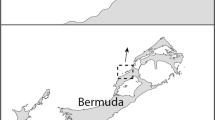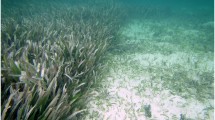Abstract
Grazing by dugongs and cropping by green turtles have the capacity to alter the subsequent nutritional quality of seagrass regrowth. We examined the effects of simulated light and intensive grazing by dugongs and cropping by turtles on eight nutritionally relevant measures of seagrass chemical composition over two regrowth periods (short-term, 1–4 months; long-term, 11–13 months) at two seagrass communities (a mixed species community with Zostera capricorni, Halophila ovalis, Halodule uninervis, Cymodocea rotundata and C. serrulate; and a monospecific bed of Halodule uninervis) in tropical Queensland, Australia. The concentrations of organic matter, total nitrogen, total water-soluble carbohydrates, total starch, neutral detergent fiber, acid detergent fiber, acid lignin, as well as the in vitro dry matter digestibility (IVDMD) were measured in the leaves and below-ground parts of each species using near-infrared reflectance spectroscopy (NIRS). Regrowth of preferred species such as H. ovalis and H. uninervis from simulated intensive dugong grazing after a year exhibited increased (by 35 and 25%, respectively, relative to controls) whole-plant N concentrations. Similarly, regrowth of H. ovalis from simulated turtle cropping showed an increase in the leaf N concentration of 30% after a year. However, these gains are tempered by reductions in starch concentrations and increases in fiber. In the short-term, the N concentrations increased while the fiber concentrations decreased. These data provide experimental support for a grazing optimization view of herbivory in the tropical seagrass system, but with feedback in a different manner. Furthermore, we suggest that in areas where grazing is the only major source of natural disturbance, it is likely that there are potential ecosystem level effects if and when numbers of dugongs and turtles are reduced.




Similar content being viewed by others
References
Adler PB, Milchunas DG, Sala OE, Burke IC, Lauenroth WK (2005) Plant traits and ecosystem grazing effects: Comparison of US sagebrush steppe and Patagonian steppe. Ecol Appl 15:774–792
Aketa K, Kawamura A (2001) Digestive functions in Sirenians (Review). Bull Fac Bioresour 27:85–103
Aketa K, Asano S, Wakai Y, Kawamura A (2001) Apparent digestibility of eelgrass in dugongs (Dugong dugon). Honyurui Kagaku (Mammalian Science) 41:23–34
Anderson PK (1994) Dugong distribution, the seagrass Halophila spinulosa, and thermal environment in winter in deeper waters of eastern Shark Bay, Western Australia. Wildl Res 21:381–388
Anderson PK (1998) Shark Bay dugongs (Dugong dugon) in summer II: foragers in a Halodule-dominated community. Mammalia 62:409–425
Anderson PK, Birtles A (1978) Behaviour and ecology of the dugong, Dugong dugon (Sirenia): observations in Shoalwater and Cleveland Bays, Queensland. Aust Wildl Res 5:1–23
André J, Lawler IR (2003) Near infrared spectroscopy as a rapid and inexpensive means of dietary analysis for a marine herbivore, dugong Dugong dugon. Mar Ecol Prog Ser 257:259–266
André J, Gyuris E, Lawler IR (2005) Comparison of the diets of sympatric dugongs and green turtles on the Orman Reefs, Torres Strait, Australia. Wildl Res 32:53–62
Aragones LV (1994) Observations on dugongs at Calauit Island, Busuanga, Palawan, Philippines. Wildl Res 21:709–717
Aragones L, Marsh H (2000) Impact of dugong grazing and turtle cropping on tropical seagrass communities. Pac Conserv Biol 5:277–288
ASTM (1995) Standard practices for infrared multivariate quantitative analysis (designation E1655–00). American Society for Testing and Materials, West Conshohocken, PA
Augustine DJ, McNaughton SJ (1998) Ungulate effects on the functional species composition of plant communities: herbivore selectivity and plant tolerance. J Wildl Manage 62:1165–1183
Augustine DJ, McNaughton SJ, Frank DA (2003) Feedbacks between soil nutrients and large herbivores in a managed savanna ecosystem. Ecol Appl 13:1325–1337
Bjorndal KA (1980) Nutrition and grazing behaviour of the green turtle Chelonia mydas. Mar Biol 56:147–154
Bjorndal KA, Bolten AB, Chaloupka MY (2000) Green turtle somatic growth model: evidence for density dependence. Ecol Appl 10:269–282
Brand SJ, Lanyon JM, Limpus CJ (1999) Digesta composition and retention times in wild immature green turtles, Chelonia mydas: a preliminary investigation. Mar Freshw Res 50:145–147
Bryant JP (2003) Winter browsing on Alaska feltleaf willow twigs improves leaf nutritional value for snowshoe hares in summer. Oikos 102:25–32
Chapman DF, Robson MJ, Snaydon RW (1992) Interactions between defoliation and the nitrogen nutrition of White Clover (Trifolium repens L.)—effects on carbon utilization in clonal plants. Plant Soil 139:157–165
Choo GM, Waterman PG, McKey DB, Gartlan JS (1981) A simple enzyme assay for dry matter digestibility and its value in studying food selection by generalist herbivores. Oecologia 49:170–178
Dawes CJ, Lawrence JM (1979) Effects of blade removal on the proximate composition of the rhizome of the seagrass Thalassia testudinum Banks ex Konig. Aquat Bot 7:255–266
De Mazancourt C, Loreau M, Abbadie L (1998) Grazing optimization and nutrient cycling: when do herbivores enhance plant production? Ecology 79:2242–2252
Foley WJ (1992) Nitrogen and energy retention and acid-base status in the common ringtail possum (Pseudocheirus peregrinus): evidence of the effects of absorbed allelochemicals. Physiol Zool 65:403–421
Foley WJ, McIlwee AP, Lawler IR, Aragones L, Woolnough AP, Berding N (1998) Ecological applications of near infrared spectroscopy—a tool for rapid, cost-effective prediction of the composition of plant and animal tissues and aspects of animal performance. Oecologia 116:293–305
Green RA, Detling JK (2000) Defoliation-induced enhancement of total aboveground nitrogen yield of grasses. Oikos 91:280–284
Hamilton EW, Giovannini MS, Moses SA, Coleman JS, McNaughton SJ (1998) Biomass and mineral element responses of a Serengeti short-grass species to nitrogen supply and defoliation: compensation requires a critical N. Oecologia 116:407–418
Heinsohn GE, Birch WR (1972) Foods and feeding habits of the dugong, Dugong dugong (Erlxlben), in Northern Queensland, Australia. Mammalia 36:412–422
Hik DS, Sadul HA, Jefferies RL (1991) Effects of the timing of multiple grazings by geese on net aboveground primary production of Swards of Puccinellia phryganodes. J Ecol 79:715–730
Hobbs NT (1996) Modification of ecosystems by ungulates. J Wildl Manage 60:695–713
de Iongh HH (1996) Plant–herbivore interactions between seagrasses and dugongs in a tropical small island ecosystem. PhD Thesis, Catholic University Nijmegen, The Netherlands
de Iongh HH, Wenno BJ, Meelis E (1995) Seagrass distribution and seasonal biomass changes in relation to dugong grazing in the Moluccas, East Indonesia. Aquat Bot 50:1–19
Jackson JBC (1997) Reefs since Columbus. Coral Reefs 16(Suppl):S23–S32
Jackson JB, Kirby MX, Berger WH, Bjorndal KA, Botsford LW, Bourque BJ, Bradbury RH, Cooke R, Erlandson J, Estes JA, Hughes TP, Kidwell S, Lange CB, Lenihan HS, Pandolfi JM, Peterson CH, Steneck RS, Tegner MJ, Warner RR (2001) Historical overfishing and the recent collapse of coastal ecosystems. Science 293:629–638
Jermyn MA (1975) Increasing the sensitivity of the anthrone method for carbohydrate. Anal Biochem 68:332–335
Komarek AR (1994) Comparison of the filter bag technique to conventional filtration in the Van Soest NDF analysis of 21 feeds. In: Proc National Conf on Forage Quality, Evaluation, and Utilization, 13–15 Apr 1994, University of Nebraska, Lincoln, NE
Lanyon J (1991) The nutritional ecology of the dugong (Dugong dugon) in tropical North Queensland. PhD thesis, Department of Ecology and Evolutionary Biology, Monash University, Melbourne
Lanyon JM, Marsh H (1995) Digesta passage times in the dugong. Aust J Zool 43:119–127
Lanyon JM, Limpus CJ, Marsh H (1989) Dugongs and turtles: grazers in the seagrass systm. In: Shepherd S (ed) Aquatic plant studies 2: biology of seagrasses with special reference to the Australian region. Elsevier, Amsterdam, pp 610–634
Lawler IR, Aragones LV, Berding N, Marsh H, Foley W (2006) Near infrared reflectance spectroscopy is a rapid, cost-effective predictor of seagrass nutrients. J Chem Ecol 32:1353–1365
Marsh H, Channels PW, Heinsohn GE, Morrissey J (1982) Analysis of stomach contents of dugongs from Queensland. Aust Wildl Res 9:55–67
Marsh H, De’ath G, Gribble N, Lane B (2005) Historical marine population estimates: triggers or targets for conservation? The dugong case study. Ecol Appl 15:481–492
Masini RJ, Anderson PK, McComb AJ (2001) A Halodule-dominated community in a subtropical embayment: physical environment, productivity, biomass, and impact of dugong grazing. Aquat Bot 71:179–197
McNaughton SJ, Banyikwa FF, McNaughton MM (1997) Promotion of the cycling of diet-enhancing nutrients by African grazers. Science 278:1798–1800
Milchunas DG, Lauenroth WK (1993) Quantitative effects of grazing on vegetation and soils over a global range of environments. Ecol Monogr 63:327–366
Murray RM, Marsh H, Heinsohn G, Spain AV (1977) The role of the midgut caecum and large intestine in the digestion of sea grasses by the dugong. Comp Biochem Physiol 56A:7–10
Nolet BA (2004) Overcompensation and grazing optimisation in a swan–pondweed system? Freshw Biol 49:1391–1399
Perry CJ, Dennison WC (1996) Effects of dugong grazing on microbial processes in seagrass sediments. In: Kuo J, Phillips RC, Walker D, Kirkman H (eds) Seagrass biology: Proceedings of an international workshop. University of Western Australia Faculty of Science, Nedlands, Australia
Perry CJ, Dennison WC (1999) Microbial nutrient cycling in seagrass sediments. AGSO J Aust Geol Geophys 17:227–231
Preen AR (1993) Interactions between dugongs and seagrasses in a subtropical environment. PhD thesis, Zoology Department, James Cook University, Townsville, Australia
Preen A (1995) Impacts of dugong foraging on seagrass habitats—observational and experimental evidence for cultivation grazing. Mar Ecol Prog Ser 124:201–213
Radojevic I, Simpson RJ, St. John JA, Humphreys MO (1994) Chemical composition and in vitro digestibility of lines of Lolium perenne selected for high concentrations of water-soluble carbohydrates. Aust J Agric Res 45:901–912
Shenk JS, Westerhaus MO (1991) Population definition, sample selection and calibration procedures for near infrared reflectance spectroscopy. Crop Sci 31:469–474
Shenk JS, Westerhaus MO (1994) The application of near infrared spectroscopy (NIRS) to forage analysis. In: Fahey GCJ, Mosser LE, Mertens DR, Collins M (eds) National Conference on Forage Quality Evaluation and Utilization. American Society of Agronomy Inc Crop Science Society of America Inc. and Soil Science Society of America Inc., Madison, WI, pp 406–449
Supanwanid C (1996) Recovery of the seagrass Halophila ovalis after grazing by dugong. In: Kuo H, Phillips RC, Walker DI, Kirkman H (eds) Seagrass biology. Rottnest Island, Western Australia, pp 315–318
Van Soest PJ, Robertson JB, Lewis BA (1991) Methods for dietary fiber, neutral detergent fiber and non-starch polysaccharides in relation to animal nutrition. J Dairy Sci 74:3583–3597
Yamamuro M, Chirapart A (2005) Quality of the seagrass Halophila ovalis on a Thai intertidal flat as food for the dugong. J Oceanogr 61:183–186
Zieman JC, Iverson RL, Ogden JC (1984) Herbivory effects on Thalassia testudinum leaf growth and nitrogen content. Mar Ecol Prog Ser 15:151–158
Acknowledgments
Professor Ross Cunningham of the Statistical Consulting Unit, Australian National University, conducted the statistical analyses. Michelle Larsen and Deanne Haffner ran some of the chemical analyses. Nils Berding of BSES (Meringa Station) allowed access to their NIRS instrument, AUSAID provided Aragones’ PhD scholarship and the Great Barrier Reef Marine Park Authority and James Cook University provided research funds.
Author information
Authors and Affiliations
Corresponding author
Additional information
Communicated by Marilyn Ball
Rights and permissions
About this article
Cite this article
Aragones, L.V., Lawler, I.R., Foley, W.J. et al. Dugong grazing and turtle cropping: grazing optimization in tropical seagrass systems?. Oecologia 149, 635–647 (2006). https://doi.org/10.1007/s00442-006-0477-1
Received:
Accepted:
Published:
Issue Date:
DOI: https://doi.org/10.1007/s00442-006-0477-1




